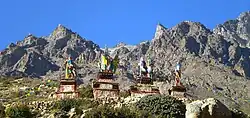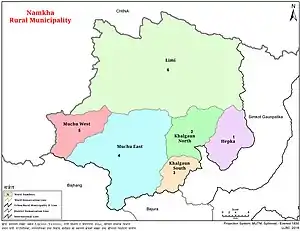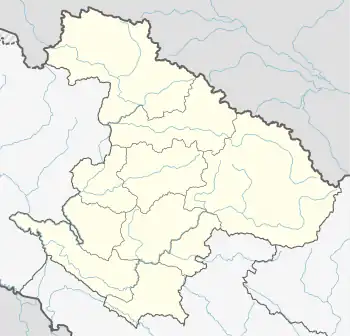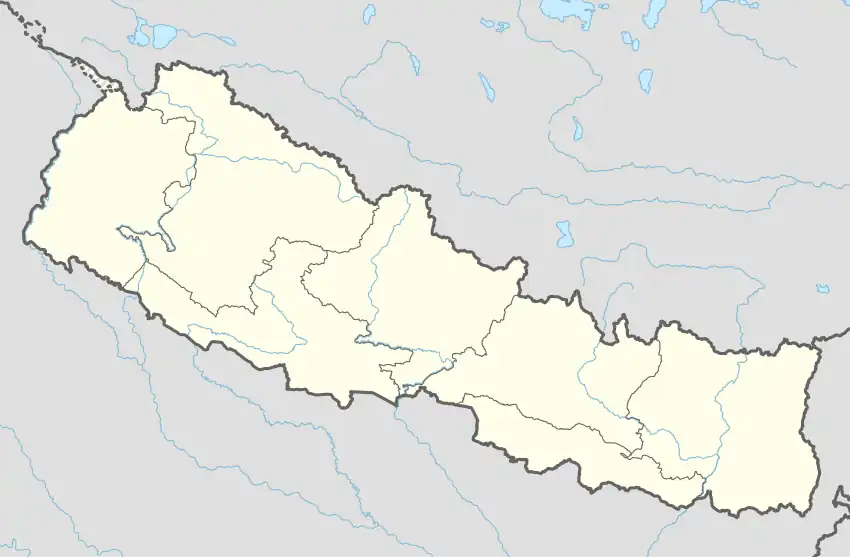Limi
लिमी | |
|---|---|
Village (Ward council) | |
 | |
| Nickname: Hidden Valley | |
 Limi (Ward No. 6) | |
 Limi Location in province  Limi Limi (Nepal) | |
| Coordinates: 30°17′N 81°39′E / 30.29°N 81.65°E | |
| Country | |
| Province | Karnali Province |
| District | Humla District |
| Rural Municipality | Namkha |
| Ward | Ward No.6 |
| Government | |
| • Type | Ward council |
| Area | |
| • Total | 1,201.29 km2 (463.82 sq mi) |
| Population (2011) | |
| • Total | 904 |
| • Density | 0.75/km2 (1.9/sq mi) |
| • Religions | Tibetan Buddhism |
| Time zone | UTC+5:45 (Nepal Time) |
| Website | namkhamun.gov.np |
Limi Valley is a high-altitude valley that forms the northernmost part of the Humla District of north-western Nepal. To its north, the Limi valley borders the Purang County of Tibet, China.
Administrative
Limi is a ward council of the Namkha rural municipality of the Humla district, which itself is a part of the Karnali Province. Previously the whole valley was known as the Limi Village Development Committee (VDC). As of the 1991 Nepal census, Limi valley had a population of 988 persons living in 169 individual households.[1] The population of the valley decreased to 904 individual according to 2011 Nepal census.[2]
Geography
The Limi valley is drained by the Limi river, a tributary of the Humla Karnali river. This valley has only three settlements, the Dzang, Halji, and Til villages. Dzang lies at 3,920m, Halji at 3,700m, and Til at 4,100m above sea level.[3] Halji village is located on the southern slopes of the Gurla Mandhata massif.[4]
Access
To go to the Limi valley, one first needs to travel to Simikot, the headquarters of district Humla. Presently, the only way of traveling to Simikot, other than going on foot for several days, is to take a flight from Nepalgunj in the western Nepali plains. Limi valley can be accessed from Simikot by two routes.[5] One follows the upstream course of the Humla Karnali river from Simikot to Hilsa; crosses the river at Hilsa, and climbs up the eastward trail to Limi valley. This route enters near Til village. Walking this route takes 5-7 days. The other route also begins by following the Humla Karnali river in an upstream direction, but diverges to turn north at the confluence of the Salli Khola and Humla Karnali rivers. This route goes over the 4,995m high Nyalu Lagna pass, enters Talung valley, and after another day's march, enters the Limi valley near Takche, east of village Dzang. Walking this route takes 4-5 days. A rough motorable road has been built from the Sino-Nepal border near Lapcha La pass till Salli Khola; it connects the eastern end of Limi, near Dzang, by road to Taklakot in Tibet (China).
A permit is required to visit the northern areas of Humla, including Simikot and Limi valley.[6]
Culture
The local inhabitants of the Limi valley, called the Limey,[7] follow the Drikung Kagyu school of Tibetan Buddhism, and there is a small gonpa in each village.[8] The Limey economy has traditionally been dependent on agriculture, supplemented by pastoralism and trade.[9] Over history and in the present times, the Limi valley community has had various kinds of close ties with the neighboring region of Tibet.[10][11][12][13][14] The Rinchenling gonpa at Halji is said to have been built by Lotsawa Rinchen Zangpo in the 11th century AD, and bears significant resemblances with the Tabo monastery in Spiti valley, India - also said to have been built by Rinchen Zangpo.[15] Limi valley is also known for the Lapcha La pass, on the border with Tibet, from where one gets an expansive view of Lake Manasarovar and the distant Mount Kailash on a clear day.[16][17]
Wildlife
The snow leopard, Himalayan wolf, Tibetan fox, Tibetan gazelle, kiang, argali, Himalayan brown bear, and Himalayan blue sheep have been reported from Limi.[18][19] Wild yak, once thought to be extinct in Nepal since five decades, was reported from the Limi valley in 2014.[20][21] Limi valley and its neighboring parts of upper Humla are rich in bird diversity.[22]
Climate Change
Since 2004, a series of GLOFs have come threateningly close Halji Richenling monastery, while also destroying parts of the Halji village. Scientists have linked these GLOFs directly to global warming and climate change.[4][23][24]
In popular culture
On account of its geographic remoteness and the intactness of its culturally Tibetan heritage, the Limi valley has been called 'Shangri La' by some commentators.[25][26] In a similar vein, the Zen Buddhist teacher Joan Hallifax has called Limi valley a 'beyul'.[27] The Indian guru Sadhguru visited Limi valley to view Kailash-Manasarovar from the Lapcha La pass in September 2021.[28]
See also
References
- ↑ "Nepal Census 2001". Nepal's Village Development Committees. Digital Himalaya. Archived from the original on 12 October 2008. Retrieved 4 September 2008.
- ↑ "वडा नं. ६" [Ward No. 6] (in Nepali). Namkha rural municipality. Retrieved 17 October 2020.
- ↑ "Humla and Limi valley trek". www.yatritrekking.com. Retrieved 2022-08-06.
- 1 2 Kropáček, J.; Neckel, N.; Tyrna, B.; Holzer, N.; Hovden, A.; Gourmelen, N.; Schneider, C.; Buchroithner, M.; Hochschild, V. (2015-10-26). "Repeated glacial lake outburst flood threatening the oldest Buddhist monastery in north-western Nepal". Natural Hazards and Earth System Sciences. 15 (10): 2425–2437. doi:10.5194/nhess-15-2425-2015. hdl:20.500.11820/64439aad-d2d0-4d32-9f02-3e3d4f65db7d. ISSN 1561-8633.
- ↑ Bubriski, Kevin; Pandey, Abhimanyu (2018). Kailash Yatra: a Long Walk to Mount Kailash through Humla. New Delhi: Penguin Random House. p. 47.
- ↑ "Humla Trekking Permit". Info Nepal Tours and Treks. 2022-03-21. Retrieved 2022-08-08.
- ↑ Bate, Tara (2022-07-15). "Competing perceptions of landscape in the Limi Valley: politics, ecology and pastoralism". European Bulletin of Himalayan Research (58). doi:10.4000/ebhr.490. ISSN 0943-8254.
- ↑ "Monasteries in the region of Purang". Retrieved August 3, 2022.
- ↑ Goldstein, Melvyn (1975). "A Report on the Limi Panchayat, Humla District, Karnali Zone" (PDF). Retrieved August 8, 2022.
- ↑ Saxer, Martin (2013). "Between China and Nepal: Trans-Himalayan Trade and the Second Life of Development in Upper Humla". Cross-Currents: East Asian History and Culture Review. 2 (2): 424–446. doi:10.1353/ach.2013.0015. ISSN 2158-9674. S2CID 144666817.
- ↑ Yeh, Emily T. (2021-05-03). ""The land belonged to Nepal but the people belonged to Tibet": Overlapping sovereignties and mobility in the Limi Valley Borderland". Geopolitics. 26 (3): 919–945. doi:10.1080/14650045.2019.1628018. ISSN 1465-0045. S2CID 197727669.
- ↑ Hovden, Astrid; Havnevik, Hanna (2021), "Balancing the sacred landscape: environmental management in Limi, North-Western Nepal", Cosmopolitical Ecologies Across Asia, pp. 83–101, doi:10.4324/9781003036272-4, ISBN 9781003036272, S2CID 239514686, retrieved 2022-08-04
- ↑ Pandey, Abhimanyu; Pradhan, Nawraj; Chaudhari, Swapnil; Ghate, Rucha (2017-01-02). "Withering of traditional institutions? An institutional analysis of the decline of migratory pastoralism in the rangelands of the Kailash Sacred Landscape, western Himalayas". Environmental Sociology. 3 (1): 87–100. doi:10.1080/23251042.2016.1272179.
- ↑ Bubriski, Kevin; Pandey, Abhimanyu (2018). Kailash Yatra: a Long Walk to Mt Kailash through Humla. Penguin Random House.
- ↑ "Mimi Church and Mariette Wiebenga: A four-fold Vairocana in the Rinchen Zangpo tradition at Halji in Nepal". asianart.com. Retrieved 2022-08-05.
- ↑ Bubriski, Kevin; Pandey, Abhimanyu (2018). Kailash Yatra: a Long Walk to Mount Kailash through Humla. New Delhi: Penguin Random House. p. 1.
- ↑ "Limi-Lapcha could be an alternative route to Kailash Manasarovar". thehimalayantimes.com. Retrieved 2022-08-03.
- ↑ "Limi Valley: A threatened Shangri-La for wildlife (commentary)". Mongabay Environmental News. 2018-09-24. Retrieved 2022-08-04.
- ↑ "Wolf Research Expedition to Humla western Nepal 2015 | Himalayan Wolves Project". Retrieved 2022-08-06.
- ↑ "Mammals - Bos mutus". Retrieved August 4, 2022.
- ↑ "'Extinct' wild yak found in Humla: Study". kathmandupost.com. Retrieved 2022-08-04.
- ↑ Acharya, Raju; Ghimirey, Yadav (2016). "The remote trans-Himalayan landscapes of Limi valley, Humla district, north-west Nepal". BirdingASIA (26): 91–98.
- ↑ Crews, Chris (2015-01-08). "When the Anthropocene Came to Halji". Retrieved 2022-08-06.
- ↑ Vallangi, Neelima. "Climate change threatens 1,000-year-old monastery in remote Nepal". www.aljazeera.com. Retrieved 2022-08-06.
- ↑ "The Hidden Himalayas - Path to Shangri-La". ECS NEPAL. Retrieved 2022-08-03.
- ↑ "Limi Valley: A threatened Shangri-La for wildlife (commentary)". Mongabay Environmental News. 2018-09-24. Retrieved 2022-08-04.
- ↑ "Program Descriptions". Upaya Zen Center. Retrieved 2022-08-08.
- ↑ "You are being redirected..." thehimalayantimes.com. Retrieved 2022-08-08.
